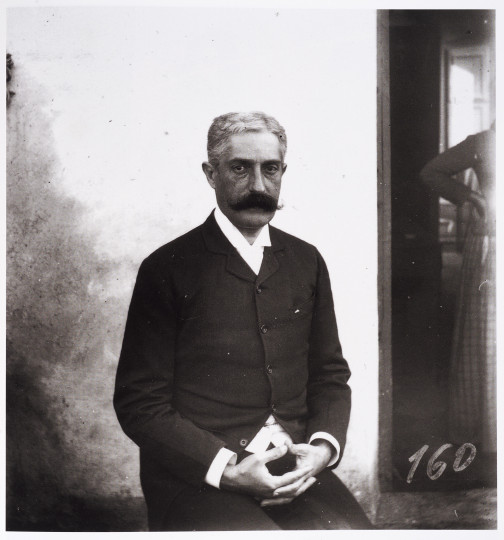THE MOST IMPORTANT COLLECTION OF VERGA'S PHOTOGRAPHS AT AUCTION

The most conspicuous set of Verga's originals in private hands, as well as the most important testimony to Giovanni Verga's photographic production, will be auctioned by Aste Bolaffi on the occasion of the sale of Rare Books and Autographs, scheduled for 21-22 June at Spazio Bolaffi in Turin (Corso Verona 34D) and live on the auction house's website (astebolaffi.it).
The consistency of the Lot is reported in the notification document produced by the Catania Superintendence for Cultural and Environmental Heritage on 11 September 2018, namely "448 documents dating from 1878 onwards, of which 327 silver bromide gelatine negative plates and 121 cellulose nitrate films". Given its great significance, the collection was in fact declared to be of particularly important historical interest. Lot 71, precious testimony to Verga's genius, will be offered from an auction starting price of 200,000 euros.
Lot 71, starting price 200,000 euros
Verga was influenced by his friend and companion Luigi Capuana who had already approached photography in the early 1860s. Those were years of great experimentation by many artists and writers such as Zola, Rimbaud and London who were confronted with this extraordinary discovery, a magnificent new means of representing and interpreting the world. As Giovanni Garra Agosta, who was the first to discover and value this medium, wrote, "Verga, more than the technically perfect aesthetic image, was interested above all in fixing on the plate that world made up of peasants, workers, maids and washerwomen", in other words, those humble people who inspired the characters in his novels. However, his first subjects were family members and then his closest friends. Among the most successful portraits, in addition to the family ones, were those of his famous contemporaries such as Giuseppe Giacosa, Arrigo Boito, Luigi Capuana, De Roberto and Pascarella, Eleonora Duse, the Treves and many others.
The landscapes and the numerous towns and cities, all Sicilian, are very moving, starting from his native town of Vizzini, Via Catania, and Segesta, as well as continental, such as Como, the Stelvio and Switzerland with Lucerne and Berne, and including a magnificent view of the Basilica of Superga in Turin. "One cannot then fail to perceive in them the incumbency of the blacks – the blacks of the hair, of the eyes, of the clothes, and the blacks of harsh and sharp lava stone that invade the backgrounds against the incandescent and dazzling white of the Sicilian light," as Vincenzo Consolo wrote in the beautiful introductory essay to the catalogue of this collection.
The final judgement as to whether photography can be considered a model for Giovanni Verga's writing or whether, as a 'minor art', it should be kept separate from 'high' production and for scholars. We are left with the possibility, thanks to this collection, to enjoy an extraordinary glimpse of an unusual and lesser-known Verga.
Bibliography: Giovanni Garra Agosta, Verga Fotografo, Catania, Giuseppe Maimone, 1991.
ASTA Tuesday 21 June at 2:00pm and Wednesday 22 June at 10:00am – c/o Spazio Bolaffi, Corso Verona 34D, Turin
ONLINE CATALOGUE
The consistency of the Lot is reported in the notification document produced by the Catania Superintendence for Cultural and Environmental Heritage on 11 September 2018, namely "448 documents dating from 1878 onwards, of which 327 silver bromide gelatine negative plates and 121 cellulose nitrate films". Given its great significance, the collection was in fact declared to be of particularly important historical interest. Lot 71, precious testimony to Verga's genius, will be offered from an auction starting price of 200,000 euros.
Lot 71, starting price 200,000 euros
Verga was influenced by his friend and companion Luigi Capuana who had already approached photography in the early 1860s. Those were years of great experimentation by many artists and writers such as Zola, Rimbaud and London who were confronted with this extraordinary discovery, a magnificent new means of representing and interpreting the world. As Giovanni Garra Agosta, who was the first to discover and value this medium, wrote, "Verga, more than the technically perfect aesthetic image, was interested above all in fixing on the plate that world made up of peasants, workers, maids and washerwomen", in other words, those humble people who inspired the characters in his novels. However, his first subjects were family members and then his closest friends. Among the most successful portraits, in addition to the family ones, were those of his famous contemporaries such as Giuseppe Giacosa, Arrigo Boito, Luigi Capuana, De Roberto and Pascarella, Eleonora Duse, the Treves and many others.
The landscapes and the numerous towns and cities, all Sicilian, are very moving, starting from his native town of Vizzini, Via Catania, and Segesta, as well as continental, such as Como, the Stelvio and Switzerland with Lucerne and Berne, and including a magnificent view of the Basilica of Superga in Turin. "One cannot then fail to perceive in them the incumbency of the blacks – the blacks of the hair, of the eyes, of the clothes, and the blacks of harsh and sharp lava stone that invade the backgrounds against the incandescent and dazzling white of the Sicilian light," as Vincenzo Consolo wrote in the beautiful introductory essay to the catalogue of this collection.
The final judgement as to whether photography can be considered a model for Giovanni Verga's writing or whether, as a 'minor art', it should be kept separate from 'high' production and for scholars. We are left with the possibility, thanks to this collection, to enjoy an extraordinary glimpse of an unusual and lesser-known Verga.
Bibliography: Giovanni Garra Agosta, Verga Fotografo, Catania, Giuseppe Maimone, 1991.
ASTA Tuesday 21 June at 2:00pm and Wednesday 22 June at 10:00am – c/o Spazio Bolaffi, Corso Verona 34D, Turin
ONLINE CATALOGUE